Survival of the Shawangunks – Race Report

This report took me a little longer than usual to put together because for the first 48 hours after the race, my head felt like a jumbled mess. It was a stressful week leading up to the race and it took me a while to recover from a hard effort at the race. (I exercised this morning for the first time since Sunday and swimming 1,600 yards was a major struggle!)
That race is really something special. The area is amazing and the course is beautiful. The organization and volunteer support is top notch. It has a great feel – it’s like you’re entering into (or part of) a very small community of triathletes. The race organizers and participants and volunteers know each other. A lot of the racers are from the local area and many people were working on their 5th or 8th or 15th SOS. We were also blessed with absolutely perfect weather and lake water temperature. It is also among the hardest races that I have ever done. And I would go back and do it again in a heartbeat. (But probably not in 2009 – it’s likely to be just one or two weeks after Ironman Canada!)
Saturday:
We drove up to New Paltz on Saturday afternoon in the middle of a massive storm. Tropical Storm Hannah was passing through New York with driving rain and strong winds. The good news was that the storm was moving fast and was predicted to be out of the area by around midnight. This should give the roads and trails plenty of time to dry out before the race started on Sunday morning.
Saturday evening was the pre-race briefing and pasta dinner. It was obvious from the briefing that this is a home-grown, community-embraced race with a dedicated following. It had a small-town feel. I was very interested in the briefing because of the unusual format of the race and the fact that I’d never been to the area. Unlike most pre-race briefings, this one was actually very useful – they explained the course and the unique challenges very clearly. I met up with Todd and he answered some more of my questions about the bike course and clothing choices. After the briefing and some pasta, we headed to our hotel and hunkered down for the night.
Pre-race:
Up at 4:30am for some breakfast and final prep. I looked out the window and it was clear and dry. I had decided to wear a new tight-fitting jersey with small side pockets, an old pair of Craft tri shorts that I’d cut the pad out of and my Asics DS Trainers. I thought the shorts would be good because they don’t have big pockets and have a drawstring around the waist to tighten when I shove my shoes inside my shorts for the swims. I had trained in them a few times and knew that I could easily last 30+ miles without the pad. The Asics are light and small and I figured they would be good during the swims. I made the decision to leave my heart rate monitor at home. It wasn’t that I wanted to race without it, I was more worried about having to fiddle with it during the swims. Simplicity was best.
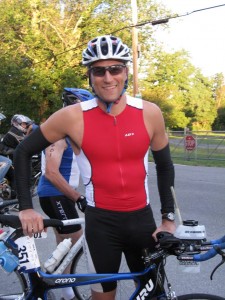
We were supposed to be at the Ulster County Fairground at around 6:15 and, typically, I was anxious to get there. We were actually out the door before 6. Once at the fairgrounds, I got marked and lined up for my start. The morning was beautiful. It was just a little cool, but clear and sunny. I was in the third wave of cyclists to start, about two minutes behind the elites in wave one.

Race start/30 mile bike:
I thought that starting a race on the bike would be a little strange, but once we were lined up and started, I didn’t even think about it. I was nervous and anxious to get started. But I did have my first (and really only) complication of the day. I could not snap my cleats into my pedals. At first I was worried that something was broken, but after a few seconds of rational thought I realized that I had just rode on them a few days before and they were fine, and the chance of both pedals or cleats breaking at the same time right before a race was about impossible. After a few minutes of effort, I reached down and cleared some mud out of each cleat (from walking through the grassy parking lot before the start!)and soon thereafter got clipped in.
The bike went fairly well. I was working hard, but not pushing it. Like most triathlons, drafting is not allowed, but it’s tough to entirely avoid it when you start on the bike. I rode most of the course with a small group, alternating positions. It was rare that there was a huge gap between us, but we weren’t “drafting”. I got passed by a few riders from the wave(s) behind me, but I was generally holding my own. At the base of the climb (about 25 miles in), we got overtaken by a large group from the 40-44 age group, who started right behind us. I’m not saying they were drafting, but I certainly was suspicious.
I drank about 450 calories of Infinit during the bike. I wanted to load up on fuel for the rest of the day. From the race lay-out and the briefing, I knew that there would be some fairly long stretches without any chance for fuel or water.
The first 25 miles of the bike are flat with some small rollers; I was averaging nearly 21 miles per hour. Then I hit the hill. It’s not the killer hill that I had envisioned and I don’t think it’s anything steeper than the hills at Lake Placid and certainly not even close to the climb at Harriman, but it’s long and there really aren’t any breaks in the climb. My average plummeted to below 19mph.
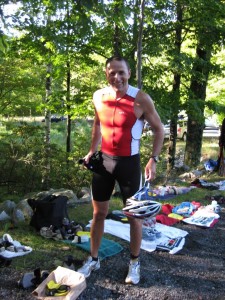
Transition 1 and Run 1:
The bike finish comes up pretty suddenly as you crest a hill and turn a slight corner. Elizabeth was there waiting with my run shoes and swim goggles and cap. We made a smooth trade and I was off for the first run.
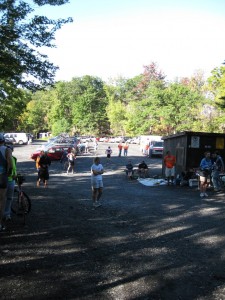
This first run felt like a normal triathlon or duathlon. Running off the bike. I could tell that I’d pushed it a little hard on the bike. My heart was beater a little harder than I would have liked and I was laboring a little, but it was still a mostly comfortable run. The trails are very well maintained and, except for the odd puddle, were dry. The first half or so of this run leg is a long climb, culminating with a steep hill. I walked a little of this hill in an effort to save my legs and get my heart rate down. During this run I found out what was to be my biggest challenge of the race – there are no mile markers during the run legs and I had never seen the course before. True, I don’t normally train with mile markers and during my training runs I can generally estimate my pace pretty well. But nearly every race I’ve ever run has mile markers. You get an idea of how hard you’re working, how much harder (or easier) you should work and how much further you have left to run. I struggled during each run to evaluate where I was and where I was going. I couldn’t even remember the course profile to know when and where there would be hills. I tried to relax and just let the run come to me, but that was much easier said than done.
Swim 1:
I got to the swim start, put on my swim cap, took off my shoes and shoved them down my shorts, put on my goggles, took a deep breath and jumped into the lake. I surfaced and my goggles were not on my face. Dammit. I looked around, didn’t see them, panicked for a second and then realized they were around my neck. Thank goodness. If I’d lost the goggles at that point, I would have been really screwed!
This swim went well. The water was warm and calm. And clear. So clear you could see the bottom the entire way. My shoes stayed in place in the back of my shorts. I put my hand back there a few times to check on them, but thankfully, they weren’t moving. They also didn’t seem to be disrupting my stroke much. My shoulders ached a bit and my hamstrings were tight, but I imagine that’s normal when you’re swimming a hard mile nearly two hours into a race. It felt a little weird to swim in my socks, but I mostly didn’t think about it and it didn’t bother me.
Similar to the first run, I was swimming hard. Harder than I do in most races. Part of that is because I was swimming totally alone. There was a large group a little ways ahead of me but they were too far to catch. Thus, no drafting. I knew I could have gained some time with a draft, but didn’t dwell on it because there was nothing to be done.
Run 2:
I got to the end of the first (and longest swim) and stepped onto the shore. As I bent down to put on my shoes, a cramp shot up my hamstring and almost toppled me. I recovered quickly, grabbed some Gatorade and Clif Shot Bloks and was off and running. The sun was out and it was nice and warm in the sun, but a little chilly in the shade. I really don’t remember this run very well. I remember that the first part of it was a gradual climb up to the top of a hill and the second half (or more) was a descent down to the Lake Minnewaska. The views from the top of this run were absolutely amazing. The sky was crystal clear. You could see Lake Awosting and the surrounding mountains and the countryside seemed to stretch out forever. Sometimes I was running near other people – I passed a few, got passed by a few – but mostly I was alone. The “trail” was more of a path, very well-maintained and pretty smooth. It was really easy to run on. Sort of like the tow path at the JFK or the Bridle Path in Central Park, just hillier!
Swim 2:
When I got to this swim start, the lake looked a little choppy. I shoved my shoes down my shorts and waded in. There was a bit of a current, but nothing nearly as bad as it looked from shore. The water was warm, but not so clear. The visibility in Lake Minnewaska was just a couple feet. But it was easy to follow the buoys and a rope that stretched across the whole course. I passed a couple of people on this swim.
Run 3:
This third run segment is the longest. You come out of the lake and run down an actual paved road before heading back onto the trails. This segment starts out downhill, then is flat for a long time. You run past an obviously very popular rock climbing and bouldering area. The people there were pretty shocked to see us come running by. This segment was the hardest for me – not only because it was long and far into the race, but because I never had any sense of where I was on the course. I was watching my splits, but couldn’t gauge my pace and even though I knew it was eight miles long, I never had any idea of how much I had left.
For nearly all of this run, I ran between two and ten feet behind a guy in my age group. He never once turned around to look behind him. I was happy sticking behind him as long as I never let him get too far ahead. There was an aid station at a bridge and I asked how far it was to the next lake. No one gave me a straight answer and I left there just as confused as when I’d arrived. At each aid station during the race, I took a cup of Gatorade and some Clif Shot Bloks. Sometimes I took water to drink and/or dump over my head. It was just warm enough to want the water on my head, but never so hot that I felt like I needed it. About six miles into this run, you turn a corner, hit an aid station and then start going up-hill. This climb is what they affectionately call “Godzilla”. It’s a two+ mile long ascent that goes from not-too-steep to too-steep-to-really-run and back again without much of a break. Again, I ran-walked up the hill; a couple minutes running, 30 seconds fast walking. It was here that I passed the guy I’d been following for so long.
At the end of this run is a little section of pretty dense forest. Then, with a quick left turn (which I missed at first), you’re at the final swim.
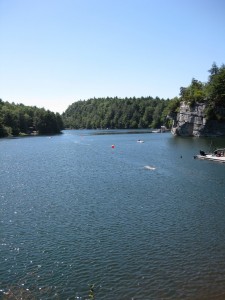
Swim 3:
When you get to this last swim, you can see the Mohonk Mountain Lodge (pictured up top). That’s essentially the finish. I got into the water right ahead of two women who were racing neck and neck for third overall woman. They are obviously better swimmers than me because they quickly left me in their wakes. I tried, tried, to keep up with them – for the draft if nothing else. But I couldn’t do it. Lake Mohonk was warm and pretty calm. This swim seemed shorter than the second swim.
Final Run:
When you get out of the water after the final swim, you actually have to climb up some rocks (see above). Under normal circumstances, this wouldn’t be a problem, but at this point in the race, even the smallest challenge is an issue. I got into my shoes quickly and started up to the Skytop Tower (and the finish line). As I started the run, there was my lovely wife cheering me on!
This final run segment is only 0.7 miles, but I’d heard horror stories about how steep it is. I couldn’t think about that, I just wanted to finish! The stories about this final run are definitely true. It feels like you’re going straight up. I ran-walked, trying to mostly run. I knew there were a few people who got out of the water just after me and my goal was to not get passed by anyone in this final segment. The spectators walking on the path all had some variation of “you’re almost there” to encourage me on. While it was true, it didn’t feel like much consolation. Right before the finish chute, there’s one more punishment – about four or five steep steps to climb. Then, it’s a semi-circle run to the finish line. And I did run that last bit. I felt like I was sprinting. And I was done! I survived!
Here’s a link to the professional/official photos of me crossing the finish line. Normally I’m conscious of the finish and the photographer. Sunday, after SOS, I was just plain done…
I was 26th to cross the finish line, with an official time of 5:11:17. Once it was all said and done, I dropped five spots because of the waves that started after me, but I still finished 31st – and fourth in my age group. It was a great race!
Here’s me and my lovely crew/biggest fan after the race:
Reflections:
As I said at the start of this report, SOS is a fantastic experience that I would totally recommend to anyone up for a tough, unique challenge. It’s hard to compare it to any other race I’ve done, but in many ways I feel like it was harder than any half ironman or even Ironman or the JFK50. It’s obviously shorter than either the Ironman or the JFK50, so how is it harder? Part of it is the intensity level. Because it’s cut up into shorter segments, I felt the need to push myself harder than I would during a longer race. In the Ironman, my goal during the swim is to be relaxed. During the JFK50, I kept my heart rate relatively low the entire time. I just wanted to make it to the end. At the SOS, there was very little relaxing or “holding back”. I didn’t go all-out, but it was close. I didn’t wear my heartrate monitor at SOS, but if I had, I’m sure I would have been pushing harder for longer than I ever imagined possible.
I’m thankful it was a beautiful day. I’ve proven that it’s possible to do a running race, a half ironman or an Ironman in the pouring rain. This race would have absolutely sucked in those types of conditions. I’m glad I got the rain out of my system at Lake Placid!
Finally, I now feel like I’ve raced in most of my “goal” running and multi-sport races in the Northeast. The ones to race, but also experience. I’m talking about well-organized races, competitive fields, nice locations. Maybe something “unique” that makes the race really worth talking about. Ones that would be worth a long drive or a flight to get to. NYC Tri, Westchester, Lake Placid, Timberman, SOS, Cherry Blossom 10 mile run, NYC Marathon, JFK50. The Boston Marathon is still on that list, but hopefully I’ll be there in April.
Total time: 5:11:17
Overall place: 31/145
AG place: 4/28
Splits:
Bike (30 miles): 1:45:42 (38th overall)
Run 1 (4.5 miles): 37:26 (35th overall)
Swim 1 (1.1 miles): 31:08 (51st overall)
Run 2 (5.5 miles): 46:27 (35th overall)
Swim 2 (0.5 miles): 17:00 (29th overall)
Run 3 (8.0 miles): 1:05:33 (29th overall)
Swim 3 (0.5 miles): 13:00 (29th overall)
Run 4 (0.7 miles): 5:05 (8th overall)
(all splits include transition times, which were each about a minute or so, I’d guess…)
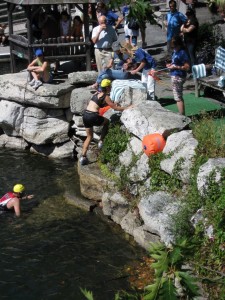

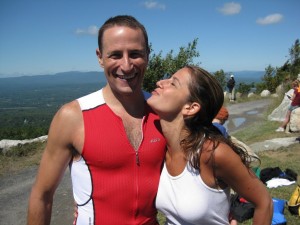
Great report. Looks like after I get the HIM under my belt, this may be the next step!
So is it now on to your ‘must do’ West Coast list? IM Canada and what else? Wildflower, Alcatraz….